인공영양(포물라)을 먹이는 방법, How to feed infant formula
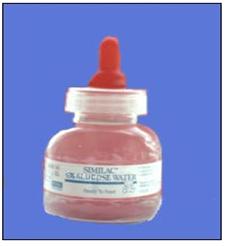
사진 3-65.신생아 경구용 5% 포도당액
소스-Ross PRODUCTS DIVISION, ABBOTT LABORATORIES, COLUMBUS, OH 43216
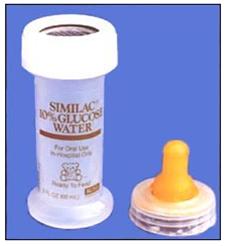
사진 3-66.신생아 경구용 10% 포도당액
소스-Ross PRODUCTS DIVISION, ABBOTT LABORATORIES, COLUMBUS, OH 43216
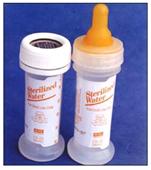
사진 3-67.신생아 경구용 살균 수
소스-Ross PRODUCTS DIVISION, ABBOTT LABORATORIES, COLUMBUS, OH 43216
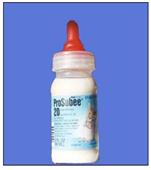
사진 3-68.인공영양 30cc에서 24 칼로리의 열량이 생길 수 있는 프로소비
소스- Mead Johnson Nutritionals, USA
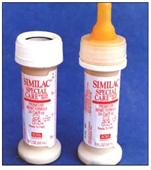
사진3-69.미숙아나 저 체중 신생아들에게 먹일 수 있는 특수 인공영양. 인공영양의 30cc에서 24 칼로리 의 열량이 생길 수 있다
소스-Ross PRODUCTS DIVISION, ABBOTT LABORATORIES, COLUMBUS, OH 43216
표 3-1. 주령이나 월령에 따라 영아가 한 번에 먹을 수 있는 인공영양의 평균 용량.
Average quantity taken in each feeding
| 영아의 나이 | 1회 먹을 수 있는 평균 량 |
| 생후1~2 주 | 2~3 온스 (60~90cc) |
| 생후 3주~2개월 | 4~5 온스 (120~150cc) |
| 생후 2~3개월 | 5~6온스 (50~180cc) |
| 생후 3~4개월 | 6~7온스 (180~210cc) |
| 생후 5~12 개월 | 7~8온스 (210~240cc) |
소스와 참고문헌; Nelson Textbook of pediatrics, 10th ed, p175
표 첫 돌 이전까지 영아의 월령에 따라 1일 먹을 수 있는 인공영양 평균 횟수
| 영아의 나이 | 1 일 먹을 수 있는 평균 횟수 |
| 갓 태어나서 부터~1주일 | 6~10회 |
| 생후 1주~1개월 | 6~8회 |
| 생후 1~3개월 | 5~6회 |
| 생후 3~7개월 | 4~5회 |
| 생후 4~9 개월 | 3~4회 |
| 생후 8~12개월 | 3회 |
소스와 참고문헌; Nelson Textbook of pediatrics, 10th ed, p175
| 정상 조건하에서 나이에 따른 소아 수분 필요량 |
| 나이 | 평균체중(kg) | 1일 총 수분량(cc) | 1일 수분필요용량(cc) (체중 매kg당) |
| 생후 3일 | 3.0 | 250-300 | 80-100 |
| 생후 10일 | 3.2 | 400-500 | 125-150 |
| 생후 3개월 | 5.4 | 750-850 | 140-160 |
| 생후 6개월 | 7.3 | 950-1100 | 130-155 |
| 생후 9개월 | 8.6 | 1,100-1,250 | 125-145 |
| 1세 | 9.5 | 1,150-1,300 | 120-135 |
| 2세 | 11.8 | 1,350-1,500 | 115-125 |
| 4세 | 16.2 | 1,600-1,800 | 100-110 |
| 6세 | 20.0 | 1,800-2,000 | 90-100 |
| 10세 | 28.7 | 2,000-2,500 | 70-85 |
| 14세 | 45.0 | 2,200-2,700 | 50-60 |
| 18세 | 54.0 | 2,200-2,700 | 40-50 |
소스:Nelson text book of pediatrics p.107
- 태어나서부터 생후 28(4주)일까지 기간을 신생아기라고 한다.
- 신생아기 기간 아기들을 신생아들이라 한다.
- 어떤 문헌에는 30일까지 신생아기라고도 한다.
- 만삭에 태어난 건강한 신생아에게 인공영양을 먹여 양육할 계획이면 생후 4~6시간에 신생아용 경구용 5% 포도당물(포도당액)이나 끓여 식힌 맹물, 또는 신생아용 멸균수 2~5cc를 시험 삼아 처음 먹여보는 것이 보통이다.
- 때로는 의사의 판단에 따라 생후 4~6시간 전 먹이기 시작할 수 있다.
- 포도당물(포도당액)이나 끓여 식힌 맹물, 또는 신생아용 멸균 수를 시험 삼아 처음 먹인 후 구토를 하지 않고, 건강에 아무 이상이 생기지 않고 그 음식물을 잘 삼키고 잘 넘기면 그 다음 인공영양 5~30cc를 시험 삼아 젖병으로 먹여 본다.
- 이 때 대부분의 건강한 만삭 신생아들은 1회분 용량 5~30cc를 한번 먹을 수 있다.
- 그 후 며칠 동안 1회분 용량 60~120cc 인공영양을 매 2~3시간마다 먹을 수 있다.
- 생후 1주 동안 대부분의 만삭 신생아들은 매 2~3시간마다 1일 6~12번 인공영양을 먹을 수 있다.
- 생후 2주 이후 대부분의 만삭 신생아들은 1회분 용량 90~150cc(3~5온스) 인공영양을 먹는 것이 보통이다.
- 그러나 신생아들이나 영아들의 나이, 체질, 또는 먹성에 따라 1회분 먹는 인공영양의 용량이나 1일 먹는 총 횟수가 조금씩 다를 수 있다.
- 신생아들이나 영아들이 배가 고파서 울 때마다 인공영양을 먹일 수 있다.
- 이렇게 먹이는 방법을 요구급식 방법(Demanding feeding) 또는 요구수유라 하고,
- 엄마의 주관에 따라 적절히 시간에 맞춰 인공영양을 먹이는 방법을 시간제 급식 방법(Schedule feeding)이라고 한다.
- 이 두 가지 급식방법을 정확하게 분별해서 인공영양을 먹일 수 없다.
- 대개는 두 가지 먹이는 방법을 절충해서 인공영양을 먹이는 것이 보통이다. (p.00 얼마나 자주 먹여야 하나 참조).
- 대부분의 초보 엄마들이 인공영양을 먹여 아기들을 키울 때 1회분 용량 인공영양을 얼마 정도가 적당한지 알고 싶어 한다.
- 1회 먹이는 1회분 인공영양의 용양이 얼마나 되어야 가장 적절 한지 그 질문에 대한 확실한 답변을 찾기가 어렵다.
- 그러나 생후 1~6개월 동안 다음과 같은 1회분 인공영양 용량을 정해 먹일 수 있다.
- 즉 예측했던 1회분 인공영양 용량에다 인공영양 30cc를 가해서 1회분 총용량으로 먹이면 문안하다.
- 다시 설명하면, 신생아들이나 영아들은 엄마들이 주는 1회분 인공영양 총량을 다 먹은 후 더 먹고 싶어도 더 달라고 말로 표현할 수가 없다.
- 그 때문에 아기가 한 번에 먹을 수 있다고 예측했던 1회분 인공영양 용량을 젖병에 담아서 먹이지 말고 예측 1회분 인공영양 총량에다 인공영양 30cc를 더 가해서 1회분으로 먹이는 것이 좋다.
- 그리고 매번 1회분 인공영양 총량을 먹고 남은 인공영양은 버려야 한다.
- 예를 들면, 2개월 영아가 1회분 120cc 인공영양의 총량을 1회에 다 먹었으면 그 다음번 먹일 때는 1회분 인공여양 120cc에다가 30cc를 더 가해 1회분 인공영양 총량을 먹인다. 이런 식으로 점차로 1회분 총량을 증가시킨다.
- 생후 4~6개월부터 영아에게 이유식을 주기 시작해도 된다.
- 영아가 이유식을 먹을 때는 한 번에 먹는 인공영양 평균 1회분 총량을 일률적으로 정하기가 더 어렵다.
- 또 이 때 부터 대부분의 영아들은 엄마들이 주는 1회분 인공영양 용량이나 이유식을 받아먹지 않고 영아 자신이 인공영양이나 이유식의 1회분 총량을 조절하기 시작한다.
- 이 때 하루에 적어도 5~6회 정도 인공영양을 먹인다.
- 이유식은 인공영양을 먹인 바로 후나 인공영양을 먹이기 바로 전, 또는 그 사이사이에 먹이는 방법이 있다.
- 생후 4~6개월 영아에게는 인공영양을 먼저 먹이고 그 다음 이유식을 먹이는 것이 좋고,
- 생후 6개월 이후부터 이유식을 먼저 먹이고 인공영양을 나중에 먹이는 것이 더 좋을 수 있다.
- 어떤 영아들은 밤중에는 인공영양을 한 번도 먹지 않고 아침까지 계속 잔다.
- 될 수 있는 한 오후 9~11시 이후 인공영양을 먹이는 것을 삼가 한다.
- 밤에는 인공영양을 한 번도 먹지 않는 아기들은 그 날 하루 낮 동안 필요로 하는 총 열량과 영양분을 충족하기위해 그날 낮 동안에 인공영양을 더 자주 많이 먹을 수 있다.
- 엄마는 아기의 나이, 크기, 또는 먹는 습성의 패턴에 맞춰 인공영양과 이유식을 먹여야 한다.
- 이런 여러 가지 이유 때문에 영유아들에게 음식물을 먹이는 것을 식이 예술 또는 식이 의술이라고도 한다.
How to feed infant formula 인공영양(포물라)을 먹이는 방법

Photo 3-65: 5% glucose solution for oral use in newborns. Source-Ross PRODUCTS DIVISION, ABBOTT LABORATORIES, COLUMBUS, OH 43216

Photo 3-66: 10% glucose solution for oral use in newborns. Source-Ross PRODUCTS DIVISION, ABBOTT LABORATORIES, COLUMBUS, OH 43216

Photo 3-67. Oral sterilization water for newborns. Source-Ross PRODUCTS DIVISION, ABBOTT LABORATORIES, COLUMBUS, OH 43216

Photo 3-68. Prosoybee, which can produce 24 calories in 30 cc of artificial nutrition. Source-Mead Johnson Nutritionals, USA

Picture 3-69. Special artificial nutrition that can be fed to premature infants and low-weight newborns. 30cc of artificial nutrition can produce 24 calories. Source-Ross PRODUCTS DIVISION, ABBOTT LABORATORIES, COLUMBUS, OH 43216
Table 3-1. The average quantity is taken in each feeding
| Infant’s age | The average amount of each feeding |
| 1 to 2 weeks after birth | 2~3 ounces (60~90cc) |
| 3 weeks to 2 months after birth | 4~5 ounces (120~150cc) |
| 2 to 3 months after birth | 5~6 ounces (50~180cc) |
| 3 to 4 months after birth | 6~7 ounces (180~210cc) |
| 5 to 12 months after birth | 7~8 ounces (210~240cc) |
Source; Nelson Textbook of pediatrics, 10th ed, p175
Table The average number of artificial nutrition that can be eaten per day according to the age of the infant before the first stone. 표 첫 돌 이전까지 영아의 월령에 따라 1일 먹을 수 있는 인공영양 평균 횟수
| infant’s age | The average number of times you can eat per day |
| Birth to 1week | 6~10 times |
| 1 week to 1month after birth | 6~8 times |
| 1 to 3 months after birth | 5~6 times |
| 3 to 7 months after birth | 4~5 times |
| 4 to 9 months after birth | 3~4 times |
| 8 to 12 months after birth | 3 times |
Source; Nelson Textbook of pediatrics, 10th ed, p175
Children’s water needs according to age under normal conditions
| Age | Average weight(kg) | Total water per day(cc) | Daily water requirement (cc) (per kg of body weight) |
| 3 days after birth일 | 3.0 | 250-300 | 80-100 |
| 10 days after birth | 3.2 | 400-500 | 125-150 |
| 3 months after birth | 5.4 | 750-850 | 140-160 |
| 6 months after birth | 7.3 | 950-1100 | 130-155 |
| 9 months after birth | 8.6 | 1,100-1,250 | 125-145 |
| 1 year old | 9.5 | 1,150-1,300 | 120-135 |
| 2 years old | 11.8 | 1,350-1,500 | 115-125 |
| 4 years old | 16.2 | 1,600-1,800 | 100-110 |
| 6 years old | 20.0 | 1,800-2,000 | 90-100 |
| 10 years old | 28.7 | 2,000-2,500 | 70-85 |
| 14 years old | 45.0 | 2,200-2,700 | 50-60 |
| 18 years old | 54.0 | 2,200-2,700 | 40-50 |
Sources and references; Nelson textbook of pediatrics p.107
- The period from birth to 28 days (4 weeks) after birth is called the neonatal period.
- Babies in the neonatal period are called newborns. In some literature, it is referred to as the neonatal period up to 30 days.
- If you plan to nurture healthy newborns born at full term by feeding artificial nutrients, you should first feed them with oral 5% glucose (glucose solution) or boiled cold water for newborns or 2 to 5 cc of sterile water for newborns at 4-6 hours after birth.
- It is normal, Sometimes, at the doctor’s discretion, feeding can be started 4 to 6 hours after birth.
- After first feeding with glucose (glucose solution), boiled cold water, or sterile water for newborns, the newborns do not vomit after the first feeding, and if there is no abnormality in health, swallow the food well and pass it well, then artificial nutrition 5~30cc is tested.
- Try feeding it with a baby bottle.
- At this time, most healthy full-term newborns can eat 5~30cc per serving.
- After that, the newborn can eat 60~120cc of artificial nutrition every 2~3 hours per serving for several days. During the first week of life, most full-term newborns can consume artificial nutrition 6-12 times a day every 2-3 hours.
- After 2 weeks of age, most full-term newborns usually consume 90 to 150 cc (3 to 5 ounces) of artificial nutrition per serving.
- However, depending on the age, constitution, or feeding nature of newborns or infants, the amount of artificial nutrition or the total number of times a day is eaten may vary slightly.
- Newborns or infants can be fed artificial nutrition whenever they are hungry and cry.
- This feeding method is called demanding feeding.
- The method of feeding artificial nutrition at an appropriate time according to the mother’s supervision is called the schedule feeding method.
- Artificial nutrition cannot be fed by accurately discriminating between these two feeding methods.
- In general, it is common to feed artificial nutrition with a compromise between the two feeding methods. (See How Often Should I Feed).
- Most beginner mothers want to know how much artificial nutrition is appropriate for their babies when they feed on artificial nutrition.
- It is difficult to find a definite answer to the question of how much the amount of artificial nutrition for a single feed should be the most appropriate.
- However, for 1-6 months of age, the following artificial nutritional doses can be set and fed.
- In other words, if you add 30cc of artificial nutrition to the estimated amount of artificial nutrition for one batch and feed it in the total amount for one batch.
- In other words, newborns and infants can’t verbally ask for more even if they want to eat more after they’ve finished eating the total amount of artificial nutrients their mothers give.
- Therefore, it is better not to feed the baby bottle with the artificial nutritional dose that was predicted that the baby can eat at a time, but adds 30cc of artificial nutrition to the estimated total amount of artificial nutrition and feed it in one batch.
- And every time your baby eats the total amount of artificial nutrition, you should throw away the remaining artificial nutrition.
- For example, if a 2-month-old infant has consumed the total amount of artificial nutrition for a single dose of 120cc at a time, the next time she feeds, she adds 30cc to 120cc of artificial nutrition for a single dose and feeds the total amount of artificial nutrition for one batch.
- In this way, she gradually increases the total amount per serving.
- You can start giving baby food to infants from 4-6 months of age.
- When an infant is eating baby food, it is more difficult for her to uniformly determine the average total amount of artificial nutrition she eats at a time.
- Also, from this point on, most infants do not receive the one-time artificial nutritional dose or baby food given by their mothers, and the infant himself begins to control the total amount of one-time artificial nutrition or baby food.
- At this time, feed artificial nutrition at least 5-6 times a day.
- Baby food can be fed immediately after feeding artificial nutrition, immediately before or between feeding artificial nutrition.
- For infants 4-6 months old, it is better to feed artificial nutrition first and then baby food.
- After 6 months of age, it may be better to feed baby food first and then feed artificial nutrition later.
- Some infants never eat artificial nutrition during the night and continue to sleep until morning.
- If possible, refrain from feeding artificial nutrition after 9-11 pm.
- Babies who never eat artificial nutrients at night can eat more artificial nutrients during the day to meet the total calories and nutrients they need during the day and day.
- The mother should be fed artificial nutrition and baby food to match her baby’s age, size, or eating habits.
- For these various reasons, feeding infants and toddlers are also called dietary art or dietary medicine.
출처 및 참조 문헌
- NelsonTextbook of Pediatrics 22ND Ed
- The Harriet Lane Handbook 22ND Ed
- Growth and development of the children
- Red Book 32nd Ed 2021-2024
- Pediatric Nutritional Handbook American Academy of Pediatrics
- 소아가정간호백과–부모도 반의사가 되어야 한다, 이상원 저
- The pregnancy Bible. By Joan stone, MD. Keith Eddleman,MD
- Neonatology Jeffrey J.Pomerance, C. Joan Richardson
- Preparation for Birth. Berverly Savage and Dianna Smith
- 임신에서 신생아 돌보기까지. 이상원
- Breastfeeding. by Ruth Lawrence and Robert Lawrence
- Pediatric Nutritional Handbook American Academy of Pediatrics
- 소아가정간호백과–부모도 반의사가 되어야 한다, 이상원 저
- The pregnancy Bible. By Joan stone, MD. Keith Eddleman,MD
- Neonatology Jeffrey J.Pomerance, C. Joan Richardson
- Preparation for Birth. Berverly Savage and Dianna Smith
- 임신에서 신생아 돌보기까지. 이상원
- Breastfeeding. by Ruth Lawrence and Robert Lawrence
-
- www.drleepediatrics.com 제1권 소아청소년 응급 의료
- www.drleepediatrics.com 제2권 소아청소년 예방
- www.drleepediatrics.com 제3권 소아청소년 성장 발육 육아
- www.drleepediatrics.com 제4권 모유,모유수유, 이유
- www.drleepediatrics.com 제5권 인공영양, 우유, 이유식, 비타민, 미네랄, 단백질, 탄수화물, 지방
- www.drleepediatrics.com 제6권 신생아 성장 발육 육아 질병
- www.drleepediatrics.com제7권 소아청소년 감염병
- www.drleepediatrics.com제8권 소아청소년 호흡기 질환
- www.drleepediatrics.com제9권 소아청소년 소화기 질환
- www.drleepediatrics.com제10권. 소아청소년 신장 비뇨 생식기 질환
- www.drleepediatrics.com제11권. 소아청소년 심장 혈관계 질환
- www.drleepediatrics.com제12권. 소아청소년 신경 정신 질환, 행동 수면 문제
- www.drleepediatrics.com제13권. 소아청소년 혈액, 림프, 종양 질환
- www.drleepediatrics.com제14권. 소아청소년 내분비, 유전, 염색체, 대사, 희귀병
- www.drleepediatrics.com제15권. 소아청소년 알레르기, 자가 면역질환
- www.drleepediatrics.com제16권. 소아청소년 정형외과 질환
- www.drleepediatrics.com제17권. 소아청소년 피부 질환
- www.drleepediatrics.com제18권. 소아청소년 이비인후(귀 코 인두 후두) 질환
- www.drleepediatrics.com제19권. 소아청소년 안과 (눈)질환
- www.drleepediatrics.com 제20권 소아청소년 이 (치아)질환
- www.drleepediatrics.com 제21권 소아청소년 가정 학교 간호
- www.drleepediatrics.com 제22권 아들 딸 이렇게 사랑해 키우세요
- www.drleepediatrics.com 제23권 사춘기 아이들의 성장 발육 질병
- www.drleepediatrics.com 제24권 소아청소년 성교육
- www.drleepediatrics.com 제25권 임신, 분만, 출산, 신생아 돌보기
- Red book 29th-31st edition 2021
- Nelson Text Book of Pediatrics 19th- 21st Edition
- The Johns Hopkins Hospital, The Harriet Lane Handbook, 22nd edition
- 응급환자관리 정담미디어
-
소아가정간호백과–부모도 반의사가 되어야 한다, 이상원
-
Neonatal Resuscitation American heart Association
-
Neonatology Jeffrey J.Pomerance, C. Joan Richardson
-
Pediatric Resuscitation Pediatric Clinics of North America, Stephen M. Schexnayder, M.D.
-
Pediatric Critical Care, Pediatric Clinics of North America, James P. Orlowski, M.D.
-
Preparation for Birth. Beverly Savage and Dianna Smith
-
Infectious disease of children, Saul Krugman, Samuel L Katz, Ann A. Gershon, Catherine Wilfert
- Pediatric Nutritional Handbook American Academy of Pediatrics
- 소아가정간호백과–부모도 반의사가 되어야 한다, 이상원
- The pregnancy Bible. By Joan stone, MD. Keith Eddleman, MD
- Neonatology Jeffrey J. Pomerance, C. Joan Richardson
- Preparation for Birth. Beverly Savage and Dianna Smith
- 임신에서 신생아 돌보기까지. 이상원
- Breastfeeding by Ruth Lawrence and Robert Lawrence
- Infectious disease of children, Saul Krugman, Samuel L Katz, Ann A. Gershon, Catherine Wilfert
- 제4권 모유, 모유수유, 이유 참조문헌 및 출처
- 제5권 인공영양, 우유, 이유, 비타민, 단백질, 지방 탄수 화물 참조문헌 및 출처
- 제6권 신생아 성장발육 양호 질병 참조문헌 및 출처
- 소아과학 대한교과서
|
Reviewed 3/2015 Copyright ⓒ 2015 John Sangwon Lee, MD, FAAP 미국 소아과 전문의, 한국 소아청소년과 전문의 이상원 저 “부모도 반의사가 되어야 한다”-내용은 여러분들의 의사로부터 얻은 정보와 진료를 대신할 수 없습니다. “The information contained in this publication should not be used as a substitute for the medical care and advice of your doctor. There may be variations in treatment that your doctor may recommend based on individual facts and circumstances. “Parental education is the best medicine.” |